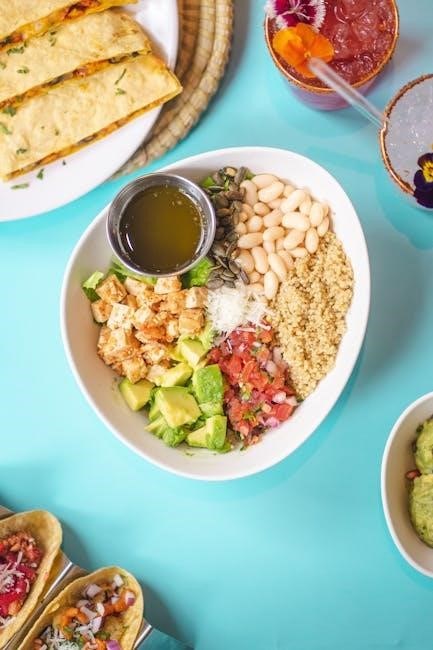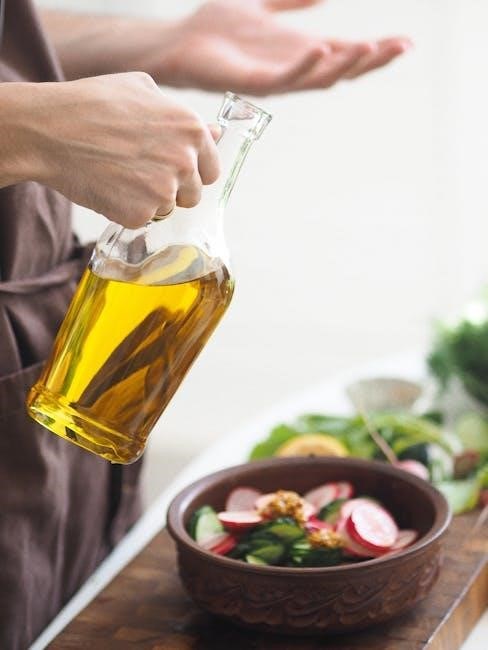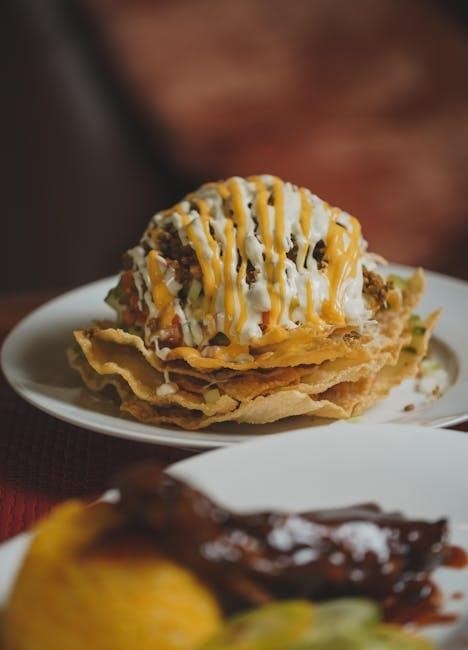
Pico de gallo, often referred to as pico dressing, is a fresh and vibrant Mexican salsa that adds a burst of flavor to various dishes․ Literally translating to “rooster’s beak,” this condiment is traditionally made from diced tomatoes, onions, jalapeños, cilantro, and lime juice․ It’s a staple in Mexican cuisine, perfect for dipping tortilla chips or enhancing tacos, burritos, and quesadillas․ Unlike cooked salsas, pico de gallo is raw, emphasizing the freshness of its ingredients․ Its bold, zesty flavor and crunchy texture make it a versatile and healthy addition to any meal․ This simple yet flavorful dish is a must-try for anyone exploring authentic Mexican flavors!
Ingredients Needed for Pico Dressing
To make authentic pico dressing, also known as pico de gallo, you’ll need a few fresh, high-quality ingredients․ The simplicity of this recipe relies on the freshness and balance of its components․ Below is a detailed list of what you’ll need:

- Tomatoes: Fresh, ripe tomatoes are the foundation of pico dressing․ Roma or plum tomatoes are ideal because they have less water content and more flesh, ensuring a chunkier texture․ You’ll need about 1 pound of Roma tomatoes (approximately 4 medium tomatoes) or 2 cups of diced fresh tomatoes (3 to 4 small tomatoes)․
- Onion: A medium white or yellow onion is typically used for its mild, sweet flavor․ Finely chop 1/2 medium onion or about 1/4 cup․ Red onion can also be used for a slightly sweeter taste․
- Jalapeño Peppers: These add a spicy kick to the dressing․ Use 1 to 2 medium jalapeños, depending on your desired level of heat․ For a milder version, remove the seeds and membranes before chopping․
- Cilantro: Fresh cilantro is essential for its vibrant, herbal flavor․ You’ll need about 1/2 cup of chopped fresh cilantro (roughly half a bunch)․
- Lime Juice: Freshly squeezed lime juice is crucial for balancing the flavors․ Use about 2 tablespoons of lime juice to add brightness and acidity to the dressing․
- Garlic: While optional, 1 to 2 garlic cloves can be added for an extra depth of flavor․ Crush or mince the garlic before mixing it in․
- Salt: A pinch of salt enhances the overall flavor․ Use it sparingly and adjust to taste․
These ingredients are readily available in most grocery stores and are often already stocked in many home kitchens․ The key to a great pico dressing is using the freshest, highest-quality produce possible․ Avoid using canned or jarred ingredients, as they can alter the texture and flavor of the final product․ If you prefer a smokier flavor, you can also add a small amount of chipotle peppers or a dash of cumin, though these are not traditional additions․
For variations, some recipes include a splash of orange juice or a sprinkle of Mexican oregano for added complexity․ However, the classic version relies on the harmony of tomatoes, onions, jalapeños, cilantro, and lime juice․ Adjust the quantities based on your personal preferences and the number of people you’re serving․ With these simple ingredients, you’ll be ready to create a delicious and authentic pico dressing that’s perfect for dipping, topping, or enhancing your favorite dishes!

Instructions for Making Pico Dressing
Creating pico dressing, or pico de gallo, is a straightforward process that requires minimal cooking skills but emphasizes fresh, high-quality ingredients․ This raw salsa is a celebration of textures and flavors, making it a perfect addition to tacos, grilled meats, vegetables, and tortilla chips․ Below is a step-by-step guide to preparing this delicious and versatile condiment:
Step 1: Prepare the Ingredients

Begin by washing and preparing all the ingredients․ Rinse the tomatoes under cold water, then gently remove the stems and core them․ Dice the tomatoes into small, uniform pieces, ensuring they remain chunky for the desired texture․ If using Roma tomatoes, you can also halve them and scoop out some of the seeds to reduce the water content․
Next, peel and finely chop the onion․ To mellow its sharpness, you can soak the chopped onion in cold water for about 5 minutes before draining and adding it to the mixture․ For the jalapeños, slice off the stems, remove the seeds (if desired for less heat), and finely chop the flesh․ Be sure to wear gloves when handling the peppers to avoid irritation from the oils․
Chop the fresh cilantro leaves coarsely, as they add a bright, herbal flavor to the dressing․ If using garlic, mince the cloves finely․ Squeeze the lime juice just before mixing to ensure its freshness and vibrancy․
Step 2: Combine the Ingredients
In a large mixing bowl, gently combine the diced tomatoes, chopped onion, jalapeños, cilantro, and garlic․ Stir the mixture carefully to avoid crushing the ingredients, which could make the texture too soggy․ Squeeze the fresh lime juice over the top and toss everything together until well-coated․
Step 3: Season to Taste
Add a pinch of salt to enhance the natural flavors of the ingredients․ Taste the dressing and adjust the seasoning if needed․ If it’s too acidic, add a bit more salt․ If it needs more brightness, squeeze in a little extra lime juice․ For a spicier version, add more jalapeño or introduce a dash of hot sauce․

Step 4: Let It Rest
Allow the pico dressing to sit at room temperature for at least 15 to 30 minutes before serving․ This resting period allows the flavors to meld together and the textures to harmonize․ Stir the mixture gently before serving to redistribute the juices․
Step 5: Serve or Store
Once ready, pico dressing can be served immediately․ It pairs perfectly with tortilla chips, tacos, grilled meats, fish, or vegetables․ For storage, transfer the mixture to an airtight container and refrigerate․ Pico dressing is best consumed fresh, but it can be stored in the fridge for up to 24 hours․ Note that the texture may become slightly softer over time due to the tomatoes releasing their juices․

By following these simple steps, you’ll have a fresh, flavorful pico dressing that’s ready to elevate any meal․ Its versatility and vibrant taste make it a staple in many kitchens, perfect for snacking, cooking, or entertaining guests․

Tips for Achieving the Best Flavor
To elevate your pico dressing, focus on balancing fresh, vibrant flavors․ Use ripe yet firm tomatoes for the best texture, and avoid over-chopping to maintain chunkiness․ Letting the mixture rest allows flavors to meld, enhancing depth․ Adjust lime juice and salt to taste, as these elements bring brightness and balance․ For a smoother texture, pulse the mixture slightly in a blender, but be cautious not to overdo it․ Experiment with add-ins like mango or avocado for unique twists, but keep the base simple․ Freshness is key, so make it just before serving for optimal taste and texture․
4․1 Choosing the Freshest Ingredients
Selecting the freshest ingredients is the foundation of a great-tasting pico dressing․ Every component plays a crucial role in the flavor and texture, so it’s essential to choose the best available produce․ Start with ripe, flavorful tomatoes, as they provide the base of the dressing․ Opt for vine-ripened or heirloom tomatoes, as they tend to have more vibrant flavor and a firmer texture that holds up well when diced․
Next, pay attention to the onions․ Red onions or white onions with a sweet, crunchy texture work best․ Avoid onions that are sprouting or have soft spots, as they may lack freshness․ Fresh cilantro is another critical ingredient, so select bunches with bright green, aromatic leaves․ Avoid wilted or yellowing cilantro, as it can give the dressing a bitter taste․
For the lime juice, use freshly squeezed juice from ripe limes․ Bottled lime juice often lacks the brightness and depth of freshly squeezed․ When it comes to peppers, whether you’re using jalapeño, serrano, or another variety, choose firm, glossy peppers with no signs of wrinkling or mold․ These small details ensure a vibrant, balanced flavor profile in your pico dressing․

Finally, select high-quality salt, preferably sea salt or kosher salt, as they enhance the flavors without adding a harsh, processed taste․ If you’re adding garlic, make sure it’s fresh and aromatic․ By taking the time to carefully choose each ingredient, you’ll create a pico dressing that’s not only delicious but also showcases the beauty of fresh, seasonal produce․
4․2 Avoiding Common Mistakes
When preparing pico dressing, there are several common mistakes that can affect the final result․ Being aware of these pitfalls and taking steps to avoid them will ensure your dressing turns out fresh, flavorful, and textured․ One of the most frequent errors is over-chopping the ingredients․ While it’s important to have a uniform consistency, over-chopping can result in a mushy texture that loses the vibrant, fresh feel of the dish․ To avoid this, chop each ingredient separately and gently, using a sharp knife to maintain clean cuts and prevent excessive tearing․
Another mistake is using unripe or low-quality tomatoes․ Tomatoes are the backbone of pico dressing, and their flavor and texture heavily influence the overall taste․ Choose ripe, flavorful tomatoes, such as vine-ripened or heirloom varieties, and avoid those that are too soft or mushy․ Additionally, don’t skip the step of draining excess moisture from the diced tomatoes․ Excess liquid can make the dressing watery and dilute the flavors․ Simply let the diced tomatoes sit for a few minutes, then pat them dry with a paper towel before adding them to the mix․
Overpowering the dressing with too much of any single ingredient is another common issue․ For example, adding too much onion or cilantro can overwhelm the other flavors, while too much lime juice can make the dressing overly acidic․ To avoid this, taste as you go and adjust the seasoning gradually․ Start with a small amount of each ingredient and add more to your liking․ This approach ensures a balanced flavor profile that highlights the freshness of each component․
Using low-quality or stale ingredients is a mistake that can significantly impact the taste․ Fresh cilantro, for instance, is essential for its bright, herbal flavor, while stale or wilted cilantro can taste bitter and unappealing․ Similarly, use fresh lime juice rather than bottled juice, as it provides a brighter, more vibrant acidity․ Freshness matters for every ingredient, so take the time to select the best produce available;
Finally, don’t forget to let the dressing sit for at least 30 minutes before serving․ This step allows the flavors to meld together and intensify, creating a more complex and satisfying taste․ Skipping this resting period can leave the dressing tasting flat and disjointed․ By avoiding these common mistakes and taking the time to prepare each step carefully, you’ll achieve a pico dressing that’s both authentic and delicious․
4․3 Adjusting Flavor to Taste
One of the best aspects of making pico dressing from scratch is the ability to tailor its flavor to your personal preferences․ This versatility allows you to tweak the recipe to suit your taste buds, whether you prefer it more tangy, spicy, sweet, or savory․ Adjusting the flavor is all about balancing the key components—acidity, sweetness, heat, and seasoning—to create a harmonious blend that enhances any dish it accompanies․
Start by tasting the dressing as you go․ This is the most straightforward way to determine if any adjustments are needed․ For instance, if the dressing feels too acidic from the lime juice, you can add a small amount of sweetness by incorporating a bit of honey, agave syrup, or even a diced mango or pineapple․ Conversely, if it’s not tangy enough, squeeze in a little more fresh lime juice․ Remember, it’s easier to add more of an ingredient than it is to remove it, so make adjustments gradually․
For those who enjoy a bit of heat, the level of spiciness can be fine-tuned by modifying the type or amount of chili peppers used․ If you prefer a milder flavor, remove the seeds and membranes of the jalapeño or serrano pepper before chopping, as these parts contain most of the heat․ Alternatively, if you want an extra kick, you can add more peppers or introduce a hotter variety, such as habanero․ Experimenting with different chili peppers can also add unique flavor profiles to the dressing․

The balance of savory and fresh flavors is another area where you can make adjustments․ If you find the dressing too sharp or overpowering, you can mellow it out by adding a bit more diced tomato or a splash of olive oil․ On the other hand, if it feels too bland, a sprinkle of salt or a squeeze of lime juice can elevate the flavors․ Fresh cilantro is another ingredient that can be adjusted to taste; some people prefer a stronger herbal note, while others opt for a more subtle presence․
Finally, don’t be afraid to think outside the box when it comes to customizing your pico dressing․ For example, adding a minced garlic clove or a splash of balsamic vinegar can introduce depth and complexity․ If you’re looking for a sweeter twist, a diced apple or a handful of chopped fresh mango can add a refreshing contrast․ The key is to taste, adjust, and iterate until the flavor resonates with your palate․

By taking the time to fine-tune the flavors, you can transform a simple pico dressing into a tailored condiment that complements your meals and satisfies your cravings; The beauty of homemade pico lies in its adaptability, so don’t hesitate to experiment and make it your own․